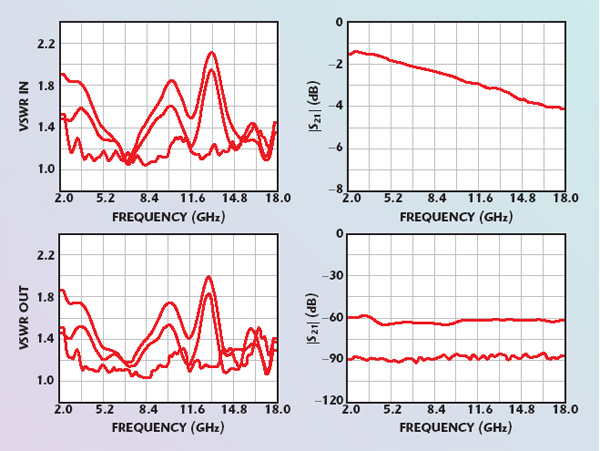Ultra Broadband, 2 - 18 GHz Digital Attenuator
|
The function of an Attenuator is to reduce the amplitude level without substantially distorting its waveform in the processing of a microwave signal. It contains a lossy element along the direction of the electromagnetic field vector, in order to disperse the energy. This article describes how to design a Digital Attenuator to convert a signal to a desired amplitude level via an electronic command. The theory of operation is to reduce the known source of power by a predetermined decibel factor. To measure the amount of attenuation necessary, the logarithm of power ratio is utilized. |
 |
|
The RF topology for this Digital Attenuator consists of a transmission line with diode spacing optimized over a desired frequency range and the digital to analog drive circuitry to control the variable analog attenuator. The key component is the choice of diode. It is an important design consideration. It is mounted in a shunt configuration with and without Q Spoiling Networks. Diodes oriented in the same direction eliminate bi-directional currents for improved temperature compensation. Using chip diodes with a ribbon lead has its drawbacks. In a high frequency broadband application, the inductance of ribbon lead adversely affects the attenuation and bandwidth. A Beam Lead Diode installed using a proprietary technique reduces the series inductance and has a significant improvement on performance. To minimize adverse effects from biasing, the network is buried as far as possible from the input and output ports. In the RF design of a Digital Attenuator, the preferred media is microstrip. Microstrip allows access to the circuitry while being measured. This provides for a more precise tuning capability. This technique yields an overall improvement in both the optimization and performance. Even with the improvement in the microwave performance, it is the control circuitry that provides the absolute accuracy for the overall device. It has to be capable of canceling the non-linear effect of the PIN diodes and provide a monotonic linear control input slope characteristic. In order to achieve the absolute accuracy for the Digital Attenuator, the digitally controlled section of the Attenuator has a resolution capable of 64K to control and compensate the Digital Attenuator. For any desired resolution, the optimal performance values for each Digital Attenuator is stored in the driver's EEproms ready to be commanded from the external Digital Control Input. This is accomplished by using a computer with I/O and IEEE controller cards, G. T. Microwave's proprietary program and a Vector Network Analyzer. The computer's I/O port sets the external control input for the desired digital attenuation, then ramps the driver's 64K of resolution down the dynamic attenuation range using another I/O port to an internal control input. While ramping the Digital Attenuator driver, the Vector Network Analyzer measures each step and sends the data to the computer via the IEEE Bus. When the optimal location is determined, the computer programs the driver's EEproms for the external control input count. The Digital Attenuator being demonstrated is optimized over a 9:1 bandwidth, 2.0-18.0 GHz with 105 dB of dynamic attenuation range and 0.03 dB resolution, 12 BITs of TTL compatible binary logic and it is capable of switching from any state to any state within 350 nanoseconds. The Insertion Loss is 5.0 dB, attenuation flatness is +/- 1.0 dB to +/- 8% of the set attenuation value and V.S.W.R. is 2.2:1. The Digital Attenuator envelope is 3.0 x 2.0 x 0.75 inch. Using the techniques described herein, the following test data illustrates the typical performance that is achieved
This technology hosts a variety of products, which include, but are not limited to: BPSK, QPSK & Vector Modulators, Phase Shifters and Phase Free Attenuators. The models are offered with options that include: digital control with up to 64K of resolution, linearized or any desired control input slope characteristic, narrowband optimized performance, temperature compensation, video filtering and sub-assembly integration. New modulation techniques will require technology to demand a new generation of components. These components will need an improved performance at a lower cost. Now, industry can welcome the arrival of ultra-broadband Digital Attenuators that will provide tomorrow's capability today at G. T. Microwave, Inc., the leading edge in performance. |
|


